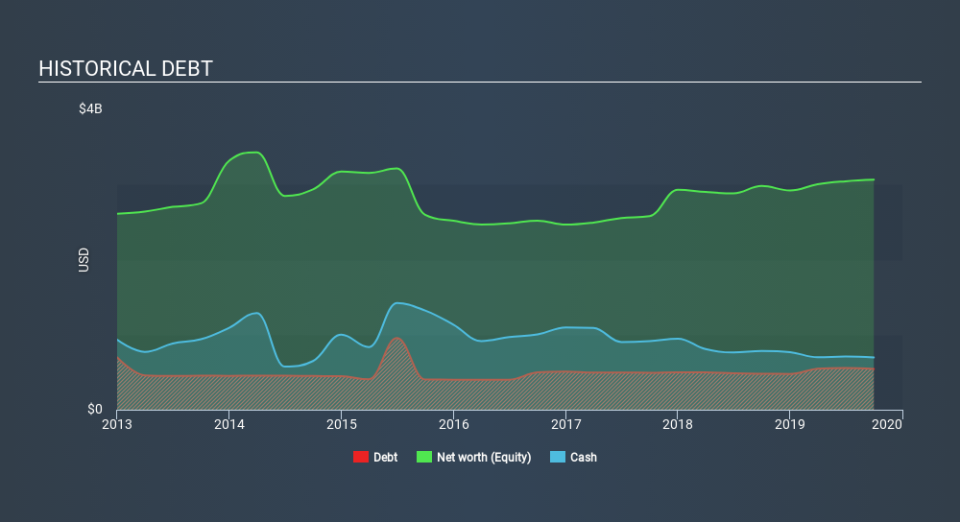Does Graham Holdings (NYSE:GHC) Have A Healthy Balance Sheet?

Warren Buffett famously said, 'Volatility is far from synonymous with risk.' When we think about how risky a company is, we always like to look at its use of debt, since debt overload can lead to ruin. As with many other companies Graham Holdings Company (NYSE:GHC) makes use of debt. But is this debt a concern to shareholders?
When Is Debt Dangerous?
Generally speaking, debt only becomes a real problem when a company can't easily pay it off, either by raising capital or with its own cash flow. Ultimately, if the company can't fulfill its legal obligations to repay debt, shareholders could walk away with nothing. However, a more usual (but still expensive) situation is where a company must dilute shareholders at a cheap share price simply to get debt under control. By replacing dilution, though, debt can be an extremely good tool for businesses that need capital to invest in growth at high rates of return. The first step when considering a company's debt levels is to consider its cash and debt together.
Check out our latest analysis for Graham Holdings
What Is Graham Holdings's Net Debt?
You can click the graphic below for the historical numbers, but it shows that as of September 2019 Graham Holdings had US$543.8m of debt, an increase on US$479.6m, over one year. But on the other hand it also has US$696.6m in cash, leading to a US$152.8m net cash position.
How Strong Is Graham Holdings's Balance Sheet?
The latest balance sheet data shows that Graham Holdings had liabilities of US$989.0m due within a year, and liabilities of US$1.44b falling due after that. Offsetting these obligations, it had cash of US$696.6m as well as receivables valued at US$621.6m due within 12 months. So its liabilities outweigh the sum of its cash and (near-term) receivables by US$1.11b.
This deficit isn't so bad because Graham Holdings is worth US$3.32b, and thus could probably raise enough capital to shore up its balance sheet, if the need arose. However, it is still worthwhile taking a close look at its ability to pay off debt. Despite its noteworthy liabilities, Graham Holdings boasts net cash, so it's fair to say it does not have a heavy debt load!
On the other hand, Graham Holdings saw its EBIT drop by 2.8% in the last twelve months. If earnings continue to decline at that rate the company may have increasing difficulty managing its debt load. The balance sheet is clearly the area to focus on when you are analysing debt. But it is Graham Holdings's earnings that will influence how the balance sheet holds up in the future. So when considering debt, it's definitely worth looking at the earnings trend. Click here for an interactive snapshot.
Finally, a business needs free cash flow to pay off debt; accounting profits just don't cut it. While Graham Holdings has net cash on its balance sheet, it's still worth taking a look at its ability to convert earnings before interest and tax (EBIT) to free cash flow, to help us understand how quickly it is building (or eroding) that cash balance. During the last three years, Graham Holdings produced sturdy free cash flow equating to 54% of its EBIT, about what we'd expect. This cold hard cash means it can reduce its debt when it wants to.
Summing up
While Graham Holdings does have more liabilities than liquid assets, it also has net cash of US$152.8m. So we are not troubled with Graham Holdings's debt use. Above most other metrics, we think its important to track how fast earnings per share is growing, if at all. If you've also come to that realization, you're in luck, because today you can view this interactive graph of Graham Holdings's earnings per share history for free.
If, after all that, you're more interested in a fast growing company with a rock-solid balance sheet, then check out our list of net cash growth stocks without delay.
If you spot an error that warrants correction, please contact the editor at editorial-team@simplywallst.com. This article by Simply Wall St is general in nature. It does not constitute a recommendation to buy or sell any stock, and does not take account of your objectives, or your financial situation. Simply Wall St has no position in the stocks mentioned.
We aim to bring you long-term focused research analysis driven by fundamental data. Note that our analysis may not factor in the latest price-sensitive company announcements or qualitative material. Thank you for reading.

 Yahoo Finance
Yahoo Finance 
